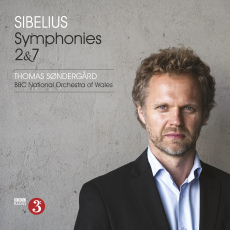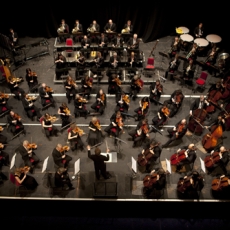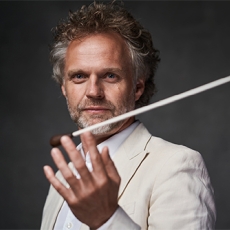Thomas Sondergard - Sibelius: Symphonies 2 & 7 - Classical Candor
If the number of releases
in the CD catalogue is any indication, Sibelius's first two symphonies remain
his most popular, with No. 2 taking
a slight edge. This is no doubt why most conductors begin their Sibelius
symphony recording cycles with one of the first two works, which is what
Maestro Thomas Sondergard and his BBC National Orchestra of Wales do here,
giving the Second a
fairly lively, and welcome, reading. With room left over, the little Seventh Symphony is
also a welcome delight.
Finnish
composer Jean Sibelius (1865-1957) wrote his Symphony No. 2
in D, Op. 43 in 1902,
and the listening public quickly dubbed it his "Symphony of
Independence," although no one is sure whether Sibelius really intended
any symbolic significance in the piece. Even so, it ends in a gloriously
victorious finale that surely draws out a feeling of freedom and self-reliance
from the music. The piece begins in a generally sunny style, though, then
builds to a powerful a climax, with a flock of heroic fanfares thrown in for good
measure.
Sondergard
takes all four movements more quickly than do the conductors on any of the half
dozen recordings I had on hand for comparison, yet his tempi are not at all
breathless. Indeed, his handling of the faster sections of the first movement is
fleet and agile, the change-ups smooth and entirely natural. When he pauses
momentarily, when he increases the volume, when he goes into a hushed whisper,
or whatever, it is with purpose; and that purpose always seems to be in the
service of the music. With evenly tuned transitions from warm to cool and back,
Sondergard's interpretation places the first movement among the best you will
find.
The
second movement Sibelius marked as an Andante (moderately
slow) and ma rubato (with a flexible tempo) to allow conductors more personal
expression. The movement begins with a distant drumroll, followed by a
pizzicato section for cellos and basses. Under Sondergard this slow movement is
appropriately somber, yet he imbues the music with a degree of comfortable affection,
too, so it's not entirely melancholy. And again, Sondergard ensures that when
he reaches the intense middle section, it doesn't appear to be coming out of
nowhere but is intrinsic to the rest of the music.
Sibelius
makes the third movement a scherzo, one that provides a dazzling display of
orchestral pyrotechnics, interrupted from time to time by a slower, more
melancholy theme. The whole thing should bounce around from an admirable
liveliness to a more pastoral theme, then a stormy midsection, and a tranquil
conclusion. This fast movement is sort of the opposite in structure of the
preceding movement: instead of two slow sections enclosing a fast one, we get
two fast sections surrounding a slow one. Sondergard generates a good deal of
enthusiasm throughout this segment, keeping both the orchestra and the audience
on their toes.
In
closing, the final movement bursts forth in explosive radiance--both thrilling
and patriotic. When the third movement glides directly into the fourth,
Sondergard might have increased the horsepower just a bit more, highlighting
the heroics. Instead, he is content to let the music speak effortlessly for
itself, and perhaps he was right in doing so. He makes a rather eloquent
statement by eschewing a certain degree of exaggeration. In the final analysis,
Sondergard's treatment of Sibelius's Second Symphony is
one of the best (and best sounding) you'll find.
Completed
in 1924 the Symphony No. 7
in C major, Op. 105, was
Sibelius's final published symphony. It is notable for being in a single,
relatively brief movement. For its first performance, he called it Fantasia sinfonica No. 1, a "symphonic fantasy." It was only a
year later, when he actually published it, that he decided he would simply call
it his Symphony No. 7. Whatever, the composer said he wanted to express
in it a "joy of life and vitality with appassionato sections." To
that extent, Sondergard takes him at his word.
One
movement or not, the music flows structurally as a symphony might, just with
more seamless continuity and cogency. Sondergard's rendering of it is, frankly,
gorgeous, one of the most brilliant, moving performances I've heard. As with
the previous work, the conductor fashions it all of a piece, with nothing that
doesn't perfectly belong. And throughout all of this music, the orchestra adds
a rich, polished luster to the proceedings. It's quite becoming.
Producer
and engineer Philip Hobbs recorded the symphonies in stereo and multichannel at
BBC Hoddinot Hall, Ckardiff, UK in March 2014. Linn Records released the hybrid
SACD for both SACD stereo and multichannel and regular CD stereo playback. I
listened to the SACD two-channel stereo layer.
The sound
has a nice airy quality, with a lifelike dimensionality about it. You can hear
the orchestra not only from side to side in a realistic spread but front to
back as though actually sitting in the audience in a concert hall. This is
typical, though, of Linn Records, who usually do their utmost to make listeners
feel as though the event were live and the ensemble were actually there in
front of you. Dynamics, frequency response, impact, and overall clarity are
also quite good, with the hall itself lending a modest resonance to the
occasion.


